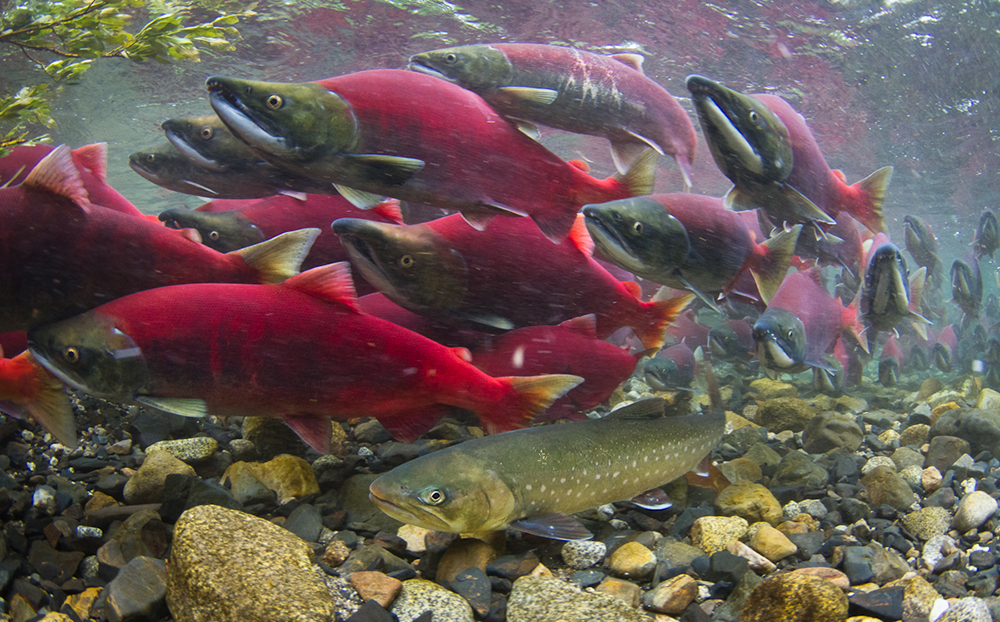
Fisheries researchers in a collaborative federal, state and university study have concluded that at-sea competition is the main driver of the decline in sockeye salmon size, with an emphasis on the tradeoff between fish abundance and body size.
The study notes that pink and sockeye salmon show high diet overlap, indicating that direct competition for food might be causing the negative link between sockeye size and pink salmon abundance.
Recent high seas salmon research in the central and eastern Gulf of Alaska suggests little spatial overlap between sockeye and pink salmon in winter/spring months, but knowledge about their spatial overlap in other areas and seasons is incomplete, the researchers said.
Study results published in February in the Proceedings of the Royal Society, an independent scientific academy of the United Kingdom, were drawn from research in the major rivers that flow into Bristol Bay in Alaska. The authors noted that declining body sizes have been documented for several species of Pacific salmon. However, whether size declines are caused mainly by ocean warming or other ecological factors, and whether they result primarily from trends in age at maturation or changing growth rates remain poorly understood, they said.
Study authors included Jan Ohlberger and Daniel E. Schindler of the University of Washington School of Aquatic and Fishery Sciences, Timothy J. Cline, at the U.S. Geological Survey’s Northern Rocky Mountain Science Center, and Bert Lewis with the Alaska Department of Fish and Game.
The four researchers quantified changes in mean body size and contributions from shifting size-at-age and age structure of mature sockeyes returning to Bristol Bay over the past 60 years. They found that mean length declined by 3%, corresponding to a 10% decline in mean body mass, since the early 1960s, though must of this decline occurred since the early 2000s.
“Record high returns of sockeye salmon to Bristol Bay during the last decade are associated with much of the observed size declines, emphasizing that there is a trade-off between fish abundance and body size,” researchers said. “Bristol Bay provides one example of how fishery management and regulatory harvesting plans can accommodate changes in body size, because stock-specific escapement goal ranges are more pre-cautionary than traditional escapement goals based solely on estimates of maximum sustained yield.”
State regulations also provide guidance to managers to achieve higher escapements in years with larger run. Thus in times of large runs with smaller fish a larger escapement is mandated by regulation, and this management structure may better account for changes in fish size, they said.
Changes in size-at-age were the dominant cause of body size declines and were more consistent than trends in age structure among major rivers flowing into Bristol Bay. Annual variation in size-at-age was largely explained by competition among Bristol Bay sockeyes and interspecific competition with other salmon in the North Pacific Ocean.
Warm winters were associated with better growth of the sockeyes, while warm summers were associated with reduced growth, they concluded.
Changes in size-at-age were found to be strongly associated with increasing abundances of Bristol Bay sockeyes and other salmon in the ocean, suggesting that competition is an important mechanism causing these size declines.
Earlier work on Bristol Bay sockeyes showed that warming waters have led to shorter freshwater rearing of juveniles in Bristol Bay sockeyes and the earlier migration from freshwater to the ocean in combination with higher salmon abundances at sea has resulted in stays in the ocean.
Sockeyes that spent one rather than two years in freshwater were more likely to return after three rather than two years at sea, suggesting that a shorter freshwater residence increases the time sockeyes feed in the ocean.
Negative associations between sockeye body size and pink salmon abundance in the ocean and the run size of sockeyes were reported previously.
